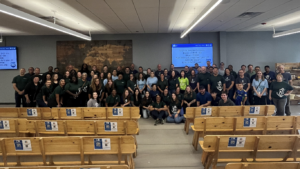Winter snow falls on the Rocky Mountains of Colorado. The spring melts the snowdrifts. The snowmelt flows down the mountain crevices, releasing an abundance of water into the Colorado River. Or that was how it used to be.
The federal government has declared a Tier 1 water shortage of the Colorado River that will affect Arizona and here’s how the City of Scottsdale plans to move forward.
The city’s water policy manager, Gretchen Baumgardner, spoke with high hopes for Scottsdale’s preparation in the event of an upcoming water shortage and introduced technologies the city is implementing that will aid citizens paychecks and the conservation effort.
READ ALSO: Analysis: Arizona boasts strong record on water management
The Colorado River Basin has been undergoing a historic drought over the last two decades and is experiencing warmer climates that have stressed its over allocated resources, according to Scottsdale Water.
The river’s water supply is shared between Mexico, Arizona and six other states, each with a specified amount of water usage allocated each year, according to Scottsdale Water.
In 2022, the elevation of the river’s reservoir, Lake Mead, is projected to get below 1,075 feet and begin a Tier 1 shortage, according to Scottsdale Water.
Arizona, Nevada, and Mexico have agreed to use less water in the event of this occurring.
At a Tier 1 shortage Scottsdale is set at a 3% reduction which translates to two million gallons per day, Baumgardner said.
At a Tier 3 shortage, water reduction is projected at 13.5 million gallons per day.
“The Colorado River watershed is something that is going to be happening for a long time,”
Baumgardner said, “and we want to understand the long-term impacts on our supply every tier.”
In preparation for a shortage, the city has stored its excess treated recycled wastewater and allotment from Central Arizona Project water in the ground for an “un-rainy day,” Baumgardner said.
The city has around 15,000 acre feet saved which is enough to make up for the event of a Tier 3 shortage, according to Baumgardner.
In another response to the shortage, Scottsdale is expanding the use of its Automatic Meter Infrastructure network to help save water.
The AMI system allows for a citizen to look at his water usage on an hourly basis to better understand how and when water is being used, Baumgardner said.
The system is integrated through an account on WaterSmart portal.
Commissioner Rachel Putman expressed her approval of the project saying, “Water is my jam, I like this.”
The city also plans to begin working with Homeowners Associations to gain information on water usage needs for landscaping.
This is a new project the city is undergoing and sees potential water saving in forgoing winter lawns, removing turf, preserving asphalt, identifying over-application, and maintaining infrastructure according to Baumgardner.
Commissioner Carol Miraldi had concerns pertaining to how this project would be carried out like getting into contact with the HOAs.
Baumgardner said they are planning on reaching out to bigger HOAs and are still in the process of deciding which ones.
The city has planned for these shortages and recognizes that it will take a team effort of citizens and businesses to be a part of the solution.




